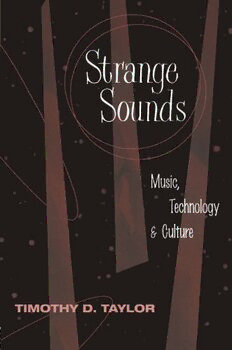
Strange Sounds: Music, Technology and Culture PDF
Preview Strange Sounds: Music, Technology and Culture
Strange Sounds Strange Sounds This page intentionally left blank trange S ounds S Music, Technology, &O ulture TIMOTHY D. TAYLOR ROUTLEDGE NEW YORK LONDON Published in 2001 by Routledge 270 Madison Ave, NewYorkNY 10016 Published in Great Britain by Routledge 2 Park Square, Milton Park, Abingdon, Oxon, OX14 4RN Routledge is an imprint of the Taylor & Francis Group. Transferred to Digital Printing 2010 Copyright © 2001 by Routledge All rights reserved. No part of this book may be printed or reproduced or utilized in any form or by electronic, mechanical, or other means, now known or hereafter invented, including photocopying and recording or in any information storage or retrieval system, without permission in writing from the publisher. The publisher and author gratefully acknowledge permission to reprint the following: An earlier version of chapter 7 appeared as "Music at Home, Politics Afar" in Decomposition: Post-Dis ciplinary Performance, edited by Sue-Ellen Case, Philip Brett, and Susan Leigh Foster, © 2000 by Indiana University Press. Example 4.1, an exceprt from "Moon Moods," music by Harry Revel, © 1946, reprinted by permission of Michael H. Goldsen, Inc., and William C. Schulman. Figure 4.5 used courtesy of Capitol Records, Inc. Figure 7.2 and figure 7.3 reprinted by permission of Geert-Jan Hobijn. Figure 8.1 and figure 8.2 reprinted by permission of Synthetic Sa:dhus. Figure 8.3, figure 8.4, and figure 8.5 reprinted by permission of Tsunami Enterprises, Inc. Cataloguing-in-Publication Data is available from the Library of Congress. ISBN 0-415-93683-7 (hbk.) - ISBN 0-415-93684-5 (pbk.) Publisher's Note The publisher has gone to great lengths to ensure the quality of this reprint but points out that some imperfections in the original may be apparent. FOR SHERRY, MY NUMBER ONLY I'm crazy about technology. I'm hooked on it. -Roni Size, "Better Music through Technology" CONTENTS List of Examples, Figures, and Tables viii Acknowledgments ix THEORY 1 Will the Revolution Be Digitized? 3 2 Music, Technology, Agency, and Practice 15 TIME 3 Postwar Music and the Technoscientific Imaginary 41 4 Men, Machines, and Music in the Space-Age 1950S 72 5 Technostalgia 96 SPACE 6 A Riddle Wrapped in a Mystery 117 7 Music at Home, Politics Afar 136 8 Turn On, Tune In, Trance Out 165 9 Anxiety, Consumption, and Agency 201 Notes 207 References 245 Index 270 EXAMPLES, FIGURES, AND TABLES LIST OF MUSIC EXAMPLES Example 4.1 Harry Revel: "Moon Moods," main chorus 84 LIST OF FIGURES Figure 3.1 Metamorphose, cover 69 Figure 4.1 Harry Revel: Music Out of the Moon (1947), cover 83 Figure 4.2 Esquivel: Other Worlds Other Sounds (1958), cover 88 Figure 4.3 Andre Montero and Warren Baker: Music for Heavenly Bodies (1958 or 1959), cover 89 Figure 4.4 Bobby Christian and His Orchestra: Strings for a Space Age (1959), cover 91 Figure 4.5 Les Baxter: Ports of Pleasure (1957), cover 92 Figure 5.1 Stereolab: The Groop Played "Space Age Batchelor Pad Music," cover 108 Figure 6.1 Difang: Circle of Life, cover 132 Figure 7.1 Stills from Packard Bell television ad 137 Figure 7.2 Self-collage by Bryn Jones of Muslimgauze 141 Figure 7.3 Muslimgauze: Hamas Arc, cover 146 Figure 7-4 Banco de Gaia: Last Train to Lhasa, cover 150 Figure 7.5 Alain Eskinasi: Many Worlds, One Tribe, cover 151 Figure 8.1 Synthetic Sadhus Flier, January 29, 2000, New York City 167 Figure 8.2 Synthetic Sadhus Flier, March 24, 2000, New York City 168 Figure 8.3 Tsunami name and logo 168 Figure 8.4 Tsunami flier (front), July 30,1999 169 Figure 8.5 Tsunami flier (front), July 16, 1999 169 LIST OF TABLES Table 3.1 Pierre Schaeffer's schematization of the "ordinary" and "new" composi tional processes 59 Table 4.1 Harry Revel: Music Out of the Moon (1947), "Moon Moods," structure 85 ACKNOWLEDGM ENTS Writing acknowledgments, for me, is the most pleasurable part of writing a book. This is in part because it is the last section to get written, but mainly because thanking one's friends, colleagues, and students is a won derful and humbling experience. The idea for this book took shape in a seminar I taught at Columbia University in the spring of 1997, "Technology and Its Effects on Music since the 1980s;' and I would like to thank those students who partici pated: Allison Armstrong, Maja Cerar, Timothy Mangin, Jason Oakes, Heather Willoughby, and Paul Yoon. I would also like to acknowledge those institutions who provided sup port of various kinds: Columbia University, for its Humanities Council Grant; the American Council of Learned Societies; and the National Humanities Center, which supported me with a grant from the National Endowment for the Humanities. I would also like to thank the NHC staff, particularly those in the library: Jean Houston and Eliza Robertson; and Karen Car roll, who copyedited most of the chapters. Other people, organizations, and agencies that provided help along the way also deserve thanks: myoid friend Lori Garver at the National Aero nautics and Space Administration, and her colleague Diana Hoyt, for help with sources about NASA in the early days. And Vanguard Records, which provided me with some press kit materials and recordings. I would also like to thank the New York City psy trance folks, especially Hugh, and ,llso Ascher, Holly, Joe, Rudston, and Tom. People at Routledge have been their usual helpful and supportive selves: first and foremost, my editor and friend, Bill Germano; Matt Byrnie, assis tant editor; Lisa Vecchione, the production editor; Brian Bendlin, the copy editor; and the indexer, Lydia Lennihan. Various friends and colleagues read bits of the manuscript or partici pated in discussions with me about some of the ideas presented here, and I would like to thank each of them: Philip Brett, Sue-Ellen Case, Luther
